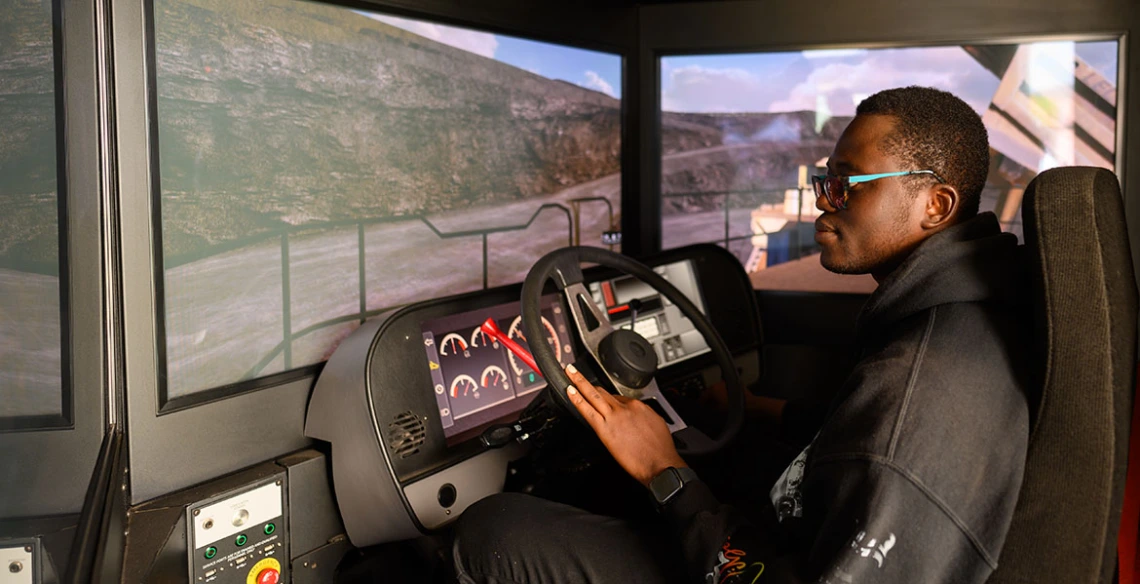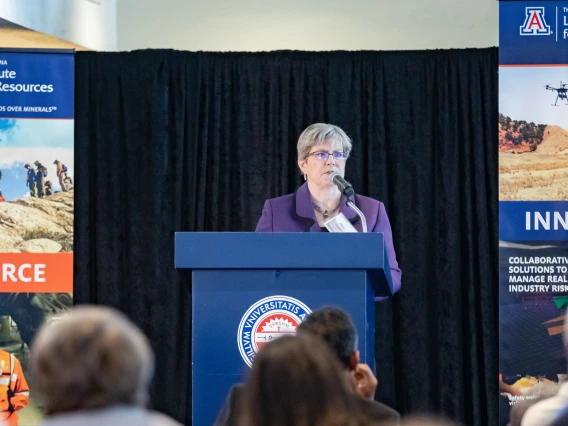University-led mining consortium vying for NSF grant up to $160M
Collaborators envision Southern Arizona as the epicenter of a sustainable, high-tech, forward-looking industry.

A U of A student uses Freeport-McMoRan’s haul truck simulator at a university event. The company is a collaborator in a regional plan to improve the mining industry and the communities that support it. In addition to mining and manufacturing companies, the public-private partnership includes government and educational organizations and technology commercialization partners.
A group led by the University of Arizona has advanced past the first round of a National Science Foundation grant funding competition that could bring up to $160 million. The NSF’s Regional Innovation Engines Development Awards program focuses on creating partnerships to accelerate technology development and spur economic growth through grants for projects spanning up to 10 years.
The NSF launched the program – also known as NSF Engines – in 2022, with an intention to make “the broadest and most significant investment in place-based science and technology research and development in the nation's history” since the 1862 Morrill Land-Grant Act established the university system.
The consortium crafted a plan, called SMILE Engine, that unites stakeholders to promote responsible mining practices, prioritize environmental sustainability, develop a skilled workforce, and foster economic development. The collaborators form one of 71 teams in the running. Having cleared the preliminary stage, SMILE Engine partners will submit a full proposal in February. NSF will announce the grantees around one year later.
Rippling out from Southern Arizona
The consortium includes collaborators from other learning institutions in addition to the U of A. Industry representatives – such as the manufacturer Komatsu and mining companies South 32 and Freeport McMoRan – joined the effort along with government organizations the city of Nogales, the Arizona Commerce Authority and the state Department of Education. SMILE Engine partners are working to engage Indigenous tribes in meaningful ways, said principal investigator Kray Luxbacher, the Gregory H. and Lisa S. Boyce Leadership Chair of Mining and Geological Engineering and head of the department.
The communities surrounding the U of A are the ideal place to begin this initiative, said Luxbacher. As well as demonstrating success in the 11-county region, the plan calls for showing how the principles could bring benefits nationwide.
"We have the right ecosystem here in Southern Arizona, with technology companies and active large mines that are critical to U.S. national security. The major mining partners in the region have joined the partnership,” she said. “And we absolutely believe success is transferable.”
Speeding sustainability and invention
The mining industry needs novel approaches to meet skyrocketing demand for minerals in an environmentally sustainable way, said Mark Schaeffer, project co-principal investigator and vice president for strategy at Komatsu Mining Technology Solutions.
The collaborators, with help from public workshops, identified several high-priority areas for use-inspired research that can quickly be commercialized and applied in the industry. The topics include alternative power sources, automation, and waste reuse. However, spurring mining innovation is difficult, Schaeffer said.
“Not many resources are available for testing ideas, since mines are operational.”
The SMILE Engine grant would allow Komatsu to work not only with other large companies but to share infrastructure with small and startup companies, thus speeding technology development.
“Komatsu is willing to work with partners to improve the industry and help it move faster,” said Schaeffer.
The university’s San Xavier Underground Mining Laboratory will also serve as a shared site for testing and optimizing equipment and processes.
Promoting local economies
Public perception often overlooks the mining industry’s contributions to society and its high-tech job opportunities, said Luxbacher. The SMILE Engine plan calls for a comprehensive educational and workforce development model engaging K-12 students, community college and university students, and adults seeking retraining.
Pima Community College Vice Chancellor of Workforce Development and Innovation Ian Roark is a co-principal investigator. The plan aligns with the college’s economic empowerment values, he said.
“It is clear to Pima Community College that mining and related industries will continue to grow in Southern Arizona over the coming decades, and this sector will provide opportunities for upward mobility for many of our learners,” said Roark.
Many communities surrounding mines are rural and home to underserved populations. For example, the city of Nogales serves as a strategic trade corridor between Mexico and the U.S. However, its residents experience high unemployment and low incomes compared to the rest of the state. The SMILE Engine will help the city leverage planned mining investments for workforce development and job creation. With strategic planning, adding more mining jobs to an area benefits all its residents, said Luxbacher. Workforce development around mine automation can also increase opportunities related to computer chips or other automation applications, for example. Also, the communities will need new homes built and more professionals such as health care providers.
“We want to make sure we’re creating holistic and sustainable communities that provide additional opportunities,” she said. “And we will offer grants to communities to meet their needs, which I expect will change over 10 years.”


